light LAND ROVER DISCOVERY 2002 Owner's Guide
[x] Cancel search | Manufacturer: LAND ROVER, Model Year: 2002, Model line: DISCOVERY, Model: LAND ROVER DISCOVERY 2002Pages: 1672, PDF Size: 46.1 MB
Page 228 of 1672

ENGINE - TD5
OVERHAUL 12-1-89
Reassembly
1.Clean drive plate, spacer, starter ring gear and
crankshaft mating faces.
2.Position starter ring gear on crankshaft, fit
spacer and drive plate.
3.Fit new bolts to retain assembly and tighten by
diagonal selection to:
lStage 1 - 40 Nm (30 lbf.ft)
lStage 2 - Further 90
°
CAUTION: Do not carry out stages 1 and 2 in
one operation.
4.Remove tool LRT-51-003, fit damper and
tighten bolts to 80 Nm (59 lbf.ft).
Starter ring gear
$% 12.53.19
Disassembly
1. Manual models: Remove flywheel.
+ ENGINE - Td5, OVERHAUL,
Flywheel.
2. Automatic models: Remove drive plate.
+ ENGINE - Td5, OVERHAUL, Drive
plate.
3.Drill a 3 mm (0.12 in) diameter hole at root of 2
teeth.
4.Apply a cold chisel to root of teeth, break ring
gear and remove from flywheel.
WARNING: SUITABLE EYE PROTECTION
MUST BE WORN.
Reassembly
1.Heat ring gear evenly to 350
° C, indicated by
light blue colour.
2.Locate ring gear on to flywheel and press on to
flange.
3.Allow ring gear to air cool.
4. Manual models: Fit flywheel.
+ ENGINE - Td5, OVERHAUL,
Flywheel.
5. Automatic models: Fit drive plate.
+ ENGINE - Td5, OVERHAUL, Drive
plate.
Page 231 of 1672
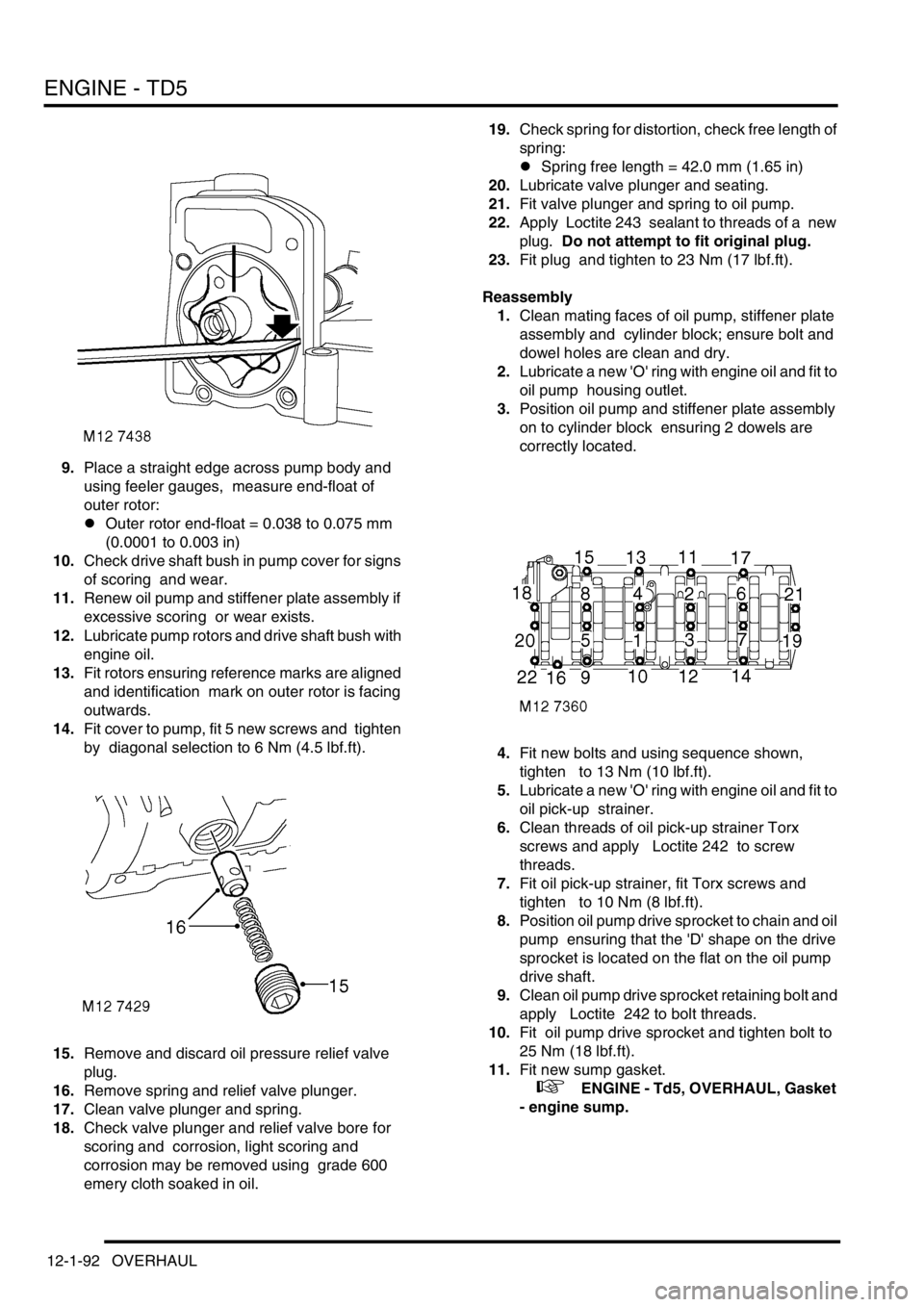
ENGINE - TD5
12-1-92 OVERHAUL
9.Place a straight edge across pump body and
using feeler gauges, measure end-float of
outer rotor:
lOuter rotor end-float = 0.038 to 0.075 mm
(0.0001 to 0.003 in)
10.Check drive shaft bush in pump cover for signs
of scoring and wear.
11.Renew oil pump and stiffener plate assembly if
excessive scoring or wear exists.
12.Lubricate pump rotors and drive shaft bush with
engine oil.
13.Fit rotors ensuring reference marks are aligned
and identification mark on outer rotor is facing
outwards.
14.Fit cover to pump, fit 5 new screws and tighten
by diagonal selection to 6 Nm (4.5 lbf.ft).
15.Remove and discard oil pressure relief valve
plug.
16.Remove spring and relief valve plunger.
17.Clean valve plunger and spring.
18.Check valve plunger and relief valve bore for
scoring and corrosion, light scoring and
corrosion may be removed using grade 600
emery cloth soaked in oil.19.Check spring for distortion, check free length of
spring:
lSpring free length = 42.0 mm (1.65 in)
20.Lubricate valve plunger and seating.
21.Fit valve plunger and spring to oil pump.
22.Apply Loctite 243 sealant to threads of a new
plug. Do not attempt to fit original plug.
23.Fit plug and tighten to 23 Nm (17 lbf.ft).
Reassembly
1.Clean mating faces of oil pump, stiffener plate
assembly and cylinder block; ensure bolt and
dowel holes are clean and dry.
2.Lubricate a new 'O' ring with engine oil and fit to
oil pump housing outlet.
3.Position oil pump and stiffener plate assembly
on to cylinder block ensuring 2 dowels are
correctly located.
4.Fit new bolts and using sequence shown,
tighten to 13 Nm (10 lbf.ft).
5.Lubricate a new 'O' ring with engine oil and fit to
oil pick-up strainer.
6.Clean threads of oil pick-up strainer Torx
screws and apply Loctite 242 to screw
threads.
7.Fit oil pick-up strainer, fit Torx screws and
tighten to 10 Nm (8 lbf.ft).
8.Position oil pump drive sprocket to chain and oil
pump ensuring that the 'D' shape on the drive
sprocket is located on the flat on the oil pump
drive shaft.
9.Clean oil pump drive sprocket retaining bolt and
apply Loctite 242 to bolt threads.
10.Fit oil pump drive sprocket and tighten bolt to
25 Nm (18 lbf.ft).
11.Fit new sump gasket.
+ ENGINE - Td5, OVERHAUL, Gasket
- engine sump.
Page 233 of 1672
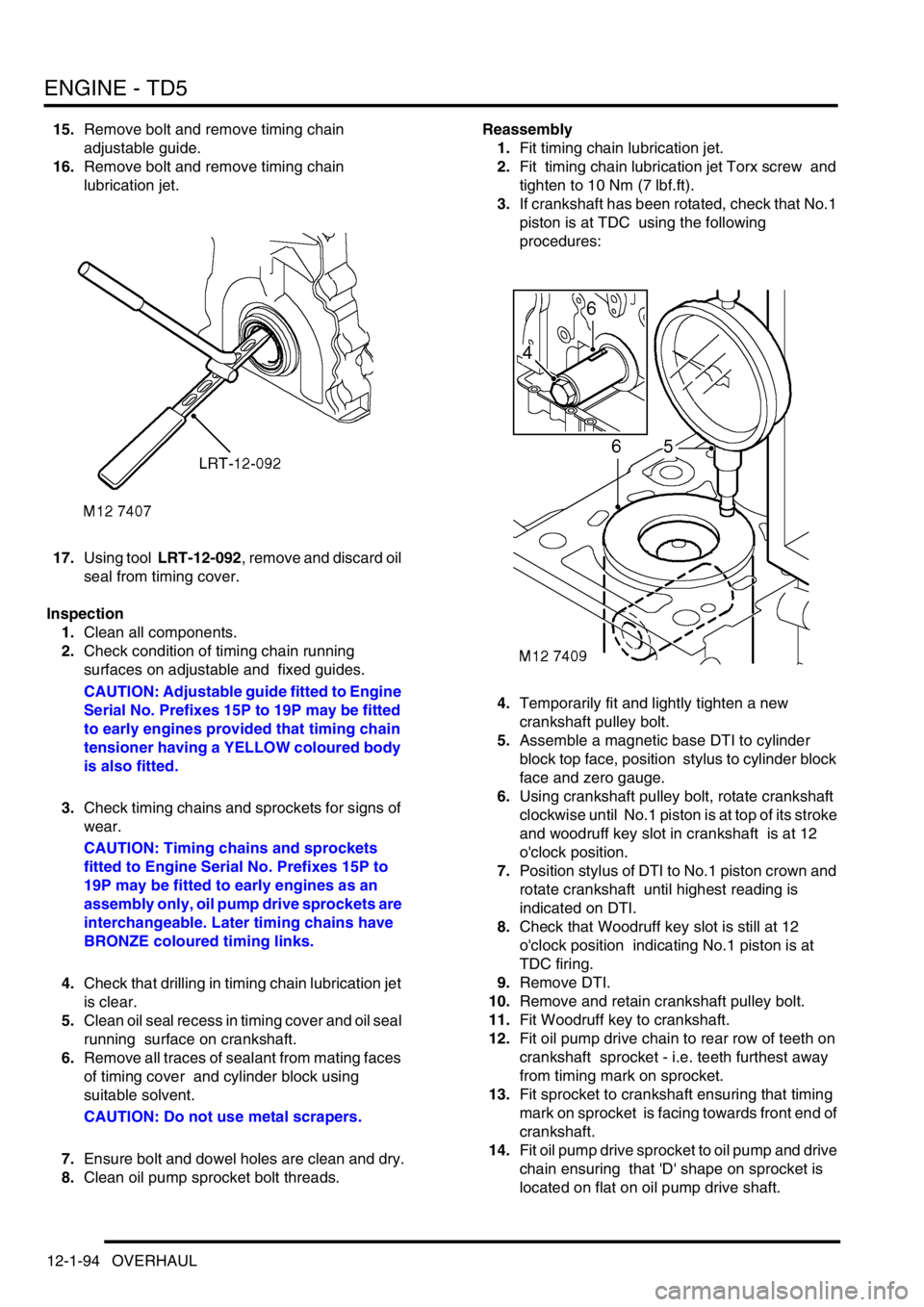
ENGINE - TD5
12-1-94 OVERHAUL
15.Remove bolt and remove timing chain
adjustable guide.
16.Remove bolt and remove timing chain
lubrication jet.
17.Using tool LRT-12-092, remove and discard oil
seal from timing cover.
Inspection
1.Clean all components.
2.Check condition of timing chain running
surfaces on adjustable and fixed guides.
CAUTION: Adjustable guide fitted to Engine
Serial No. Prefixes 15P to 19P may be fitted
to early engines provided that timing chain
tensioner having a YELLOW coloured body
is also fitted.
3.Check timing chains and sprockets for signs of
wear.
CAUTION: Timing chains and sprockets
fitted to Engine Serial No. Prefixes 15P to
19P may be fitted to early engines as an
assembly only, oil pump drive sprockets are
interchangeable. Later timing chains have
BRONZE coloured timing links.
4.Check that drilling in timing chain lubrication jet
is clear.
5.Clean oil seal recess in timing cover and oil seal
running surface on crankshaft.
6.Remove all traces of sealant from mating faces
of timing cover and cylinder block using
suitable solvent.
CAUTION: Do not use metal scrapers.
7.Ensure bolt and dowel holes are clean and dry.
8.Clean oil pump sprocket bolt threads.Reassembly
1.Fit timing chain lubrication jet.
2.Fit timing chain lubrication jet Torx screw and
tighten to 10 Nm (7 lbf.ft).
3.If crankshaft has been rotated, check that No.1
piston is at TDC using the following
procedures:
4.Temporarily fit and lightly tighten a new
crankshaft pulley bolt.
5.Assemble a magnetic base DTI to cylinder
block top face, position stylus to cylinder block
face and zero gauge.
6.Using crankshaft pulley bolt, rotate crankshaft
clockwise until No.1 piston is at top of its stroke
and woodruff key slot in crankshaft is at 12
o'clock position.
7.Position stylus of DTI to No.1 piston crown and
rotate crankshaft until highest reading is
indicated on DTI.
8.Check that Woodruff key slot is still at 12
o'clock position indicating No.1 piston is at
TDC firing.
9.Remove DTI.
10.Remove and retain crankshaft pulley bolt.
11.Fit Woodruff key to crankshaft.
12.Fit oil pump drive chain to rear row of teeth on
crankshaft sprocket - i.e. teeth furthest away
from timing mark on sprocket.
13.Fit sprocket to crankshaft ensuring that timing
mark on sprocket is facing towards front end of
crankshaft.
14.Fit oil pump drive sprocket to oil pump and drive
chain ensuring that 'D' shape on sprocket is
located on flat on oil pump drive shaft.
Page 234 of 1672
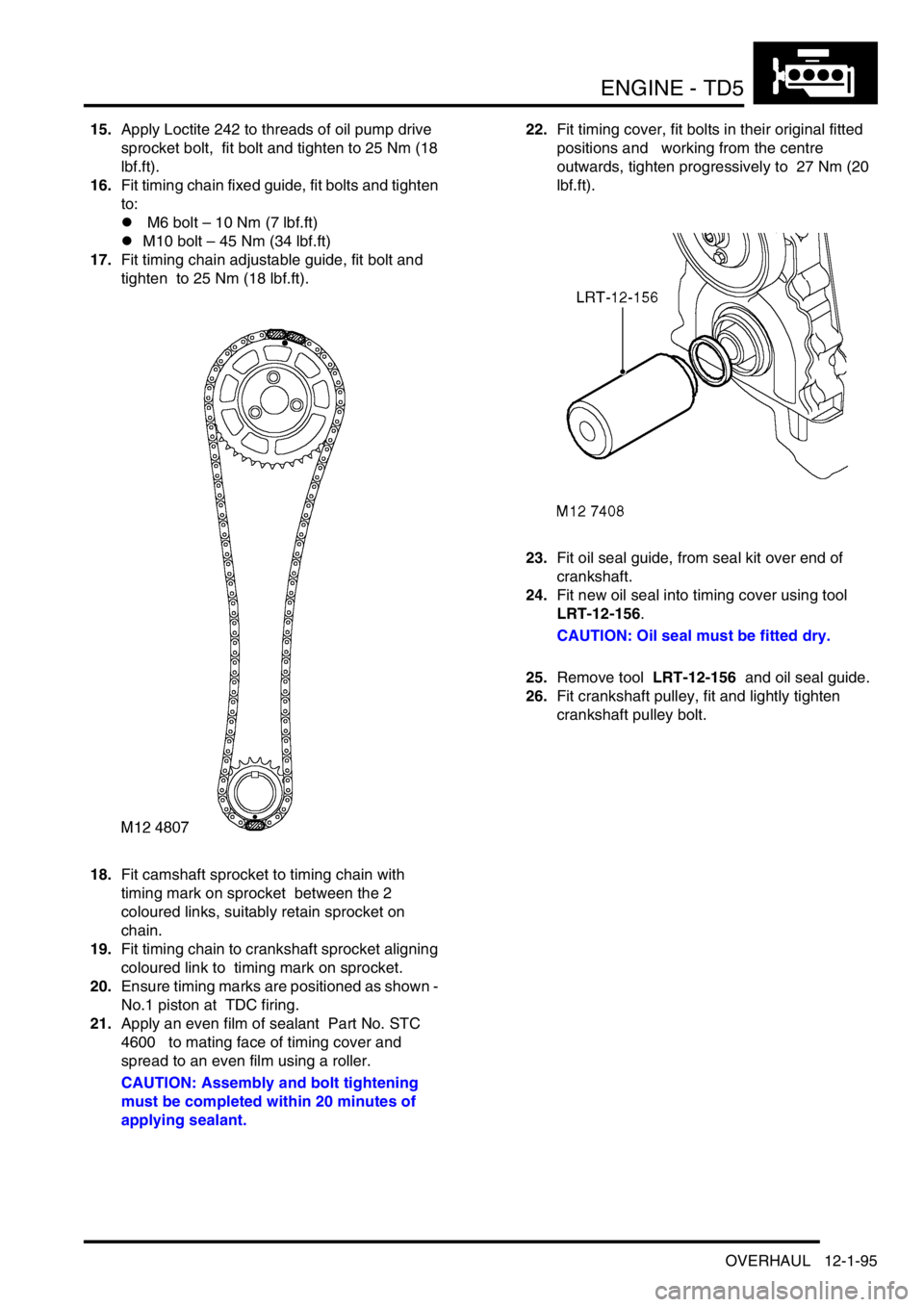
ENGINE - TD5
OVERHAUL 12-1-95
15.Apply Loctite 242 to threads of oil pump drive
sprocket bolt, fit bolt and tighten to 25 Nm (18
lbf.ft).
16.Fit timing chain fixed guide, fit bolts and tighten
to:
l M6 bolt – 10 Nm (7 lbf.ft)
lM10 bolt – 45 Nm (34 lbf.ft)
17.Fit timing chain adjustable guide, fit bolt and
tighten to 25 Nm (18 lbf.ft).
18.Fit camshaft sprocket to timing chain with
timing mark on sprocket between the 2
coloured links, suitably retain sprocket on
chain.
19.Fit timing chain to crankshaft sprocket aligning
coloured link to timing mark on sprocket.
20.Ensure timing marks are positioned as shown -
No.1 piston at TDC firing.
21.Apply an even film of sealant Part No. STC
4600 to mating face of timing cover and
spread to an even film using a roller.
CAUTION: Assembly and bolt tightening
must be completed within 20 minutes of
applying sealant.22.Fit timing cover, fit bolts in their original fitted
positions and working from the centre
outwards, tighten progressively to 27 Nm (20
lbf.ft).
23.Fit oil seal guide, from seal kit over end of
crankshaft.
24.Fit new oil seal into timing cover using tool
LRT-12-156.
CAUTION: Oil seal must be fitted dry.
25.Remove tool LRT-12-156 and oil seal guide.
26.Fit crankshaft pulley, fit and lightly tighten
crankshaft pulley bolt.
Page 236 of 1672
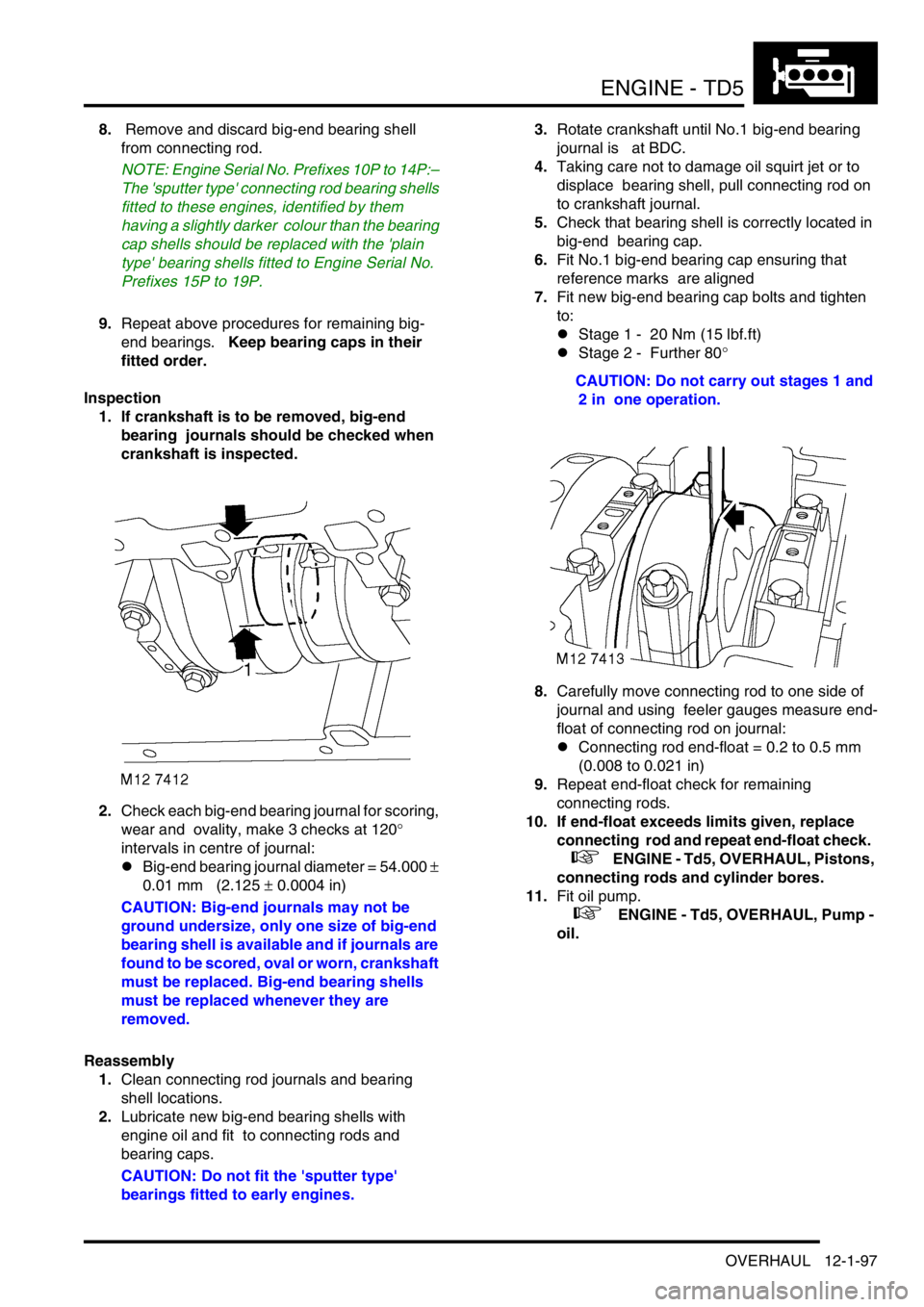
ENGINE - TD5
OVERHAUL 12-1-97
8. Remove and discard big-end bearing shell
from connecting rod.
NOTE: Engine Serial No. Prefixes 10P to 14P:–
The 'sputter type' connecting rod bearing shells
fitted to these engines, identified by them
having a slightly darker colour than the bearing
cap shells should be replaced with the 'plain
type' bearing shells fitted to Engine Serial No.
Prefixes 15P to 19P.
9.Repeat above procedures for remaining big-
end bearings. Keep bearing caps in their
fitted order.
Inspection
1. If crankshaft is to be removed, big-end
bearing journals should be checked when
crankshaft is inspected.
2.Check each big-end bearing journal for scoring,
wear and ovality, make 3 checks at 120
°
intervals in centre of journal:
lBig-end bearing journal diameter = 54.000
±
0.01 mm (2.125
± 0.0004 in)
CAUTION: Big-end journals may not be
ground undersize, only one size of big-end
bearing shell is available and if journals are
found to be scored, oval or worn, crankshaft
must be replaced. Big-end bearing shells
must be replaced whenever they are
removed.
Reassembly
1.Clean connecting rod journals and bearing
shell locations.
2.Lubricate new big-end bearing shells with
engine oil and fit to connecting rods and
bearing caps.
CAUTION: Do not fit the 'sputter type'
bearings fitted to early engines.3.Rotate crankshaft until No.1 big-end bearing
journal is at BDC.
4.Taking care not to damage oil squirt jet or to
displace bearing shell, pull connecting rod on
to crankshaft journal.
5.Check that bearing shell is correctly located in
big-end bearing cap.
6.Fit No.1 big-end bearing cap ensuring that
reference marks are aligned
7.Fit new big-end bearing cap bolts and tighten
to:
lStage 1 - 20 Nm (15 lbf.ft)
lStage 2 - Further 80
°
CAUTION: Do not carry out stages 1 and
2 in one operation.
8.Carefully move connecting rod to one side of
journal and using feeler gauges measure end-
float of connecting rod on journal:
lConnecting rod end-float = 0.2 to 0.5 mm
(0.008 to 0.021 in)
9.Repeat end-float check for remaining
connecting rods.
10. If end-float exceeds limits given, replace
connecting rod and repeat end-float check.
+ ENGINE - Td5, OVERHAUL, Pistons,
connecting rods and cylinder bores.
11.Fit oil pump.
+ ENGINE - Td5, OVERHAUL, Pump -
oil.
Page 240 of 1672
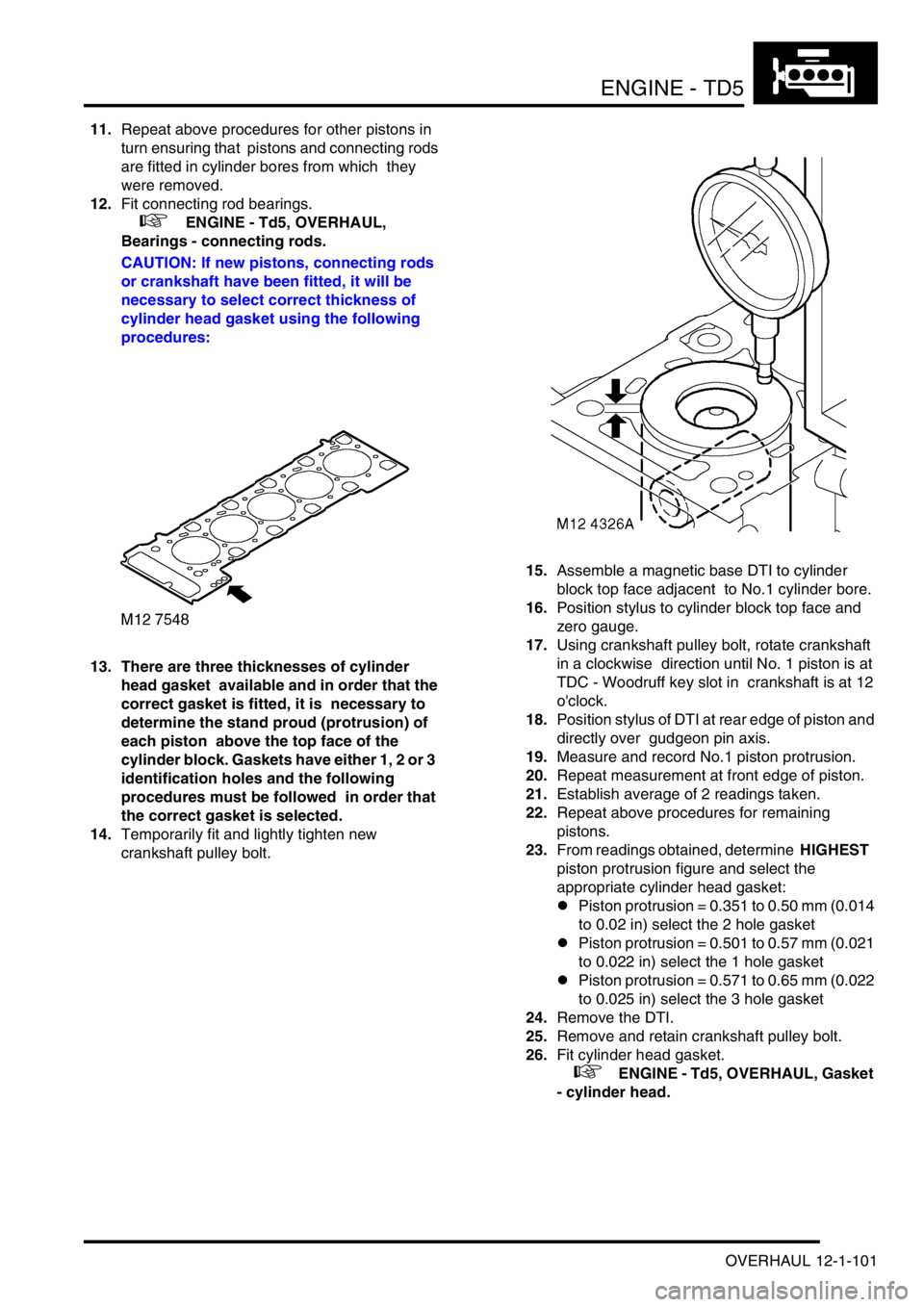
ENGINE - TD5
OVERHAUL 12-1-101
11.Repeat above procedures for other pistons in
turn ensuring that pistons and connecting rods
are fitted in cylinder bores from which they
were removed.
12.Fit connecting rod bearings.
+ ENGINE - Td5, OVERHAUL,
Bearings - connecting rods.
CAUTION: If new pistons, connecting rods
or crankshaft have been fitted, it will be
necessary to select correct thickness of
cylinder head gasket using the following
procedures:
13. There are three thicknesses of cylinder
head gasket available and in order that the
correct gasket is fitted, it is necessary to
determine the stand proud (protrusion) of
each piston above the top face of the
cylinder block. Gaskets have either 1, 2 or 3
identification holes and the following
procedures must be followed in order that
the correct gasket is selected.
14.Temporarily fit and lightly tighten new
crankshaft pulley bolt. 15.Assemble a magnetic base DTI to cylinder
block top face adjacent to No.1 cylinder bore.
16.Position stylus to cylinder block top face and
zero gauge.
17.Using crankshaft pulley bolt, rotate crankshaft
in a clockwise direction until No. 1 piston is at
TDC - Woodruff key slot in crankshaft is at 12
o'clock.
18.Position stylus of DTI at rear edge of piston and
directly over gudgeon pin axis.
19.Measure and record No.1 piston protrusion.
20.Repeat measurement at front edge of piston.
21.Establish average of 2 readings taken.
22.Repeat above procedures for remaining
pistons.
23.From readings obtained, determine HIGHEST
piston protrusion figure and select the
appropriate cylinder head gasket:
lPiston protrusion = 0.351 to 0.50 mm (0.014
to 0.02 in) select the 2 hole gasket
lPiston protrusion = 0.501 to 0.57 mm (0.021
to 0.022 in) select the 1 hole gasket
lPiston protrusion = 0.571 to 0.65 mm (0.022
to 0.025 in) select the 3 hole gasket
24.Remove the DTI.
25.Remove and retain crankshaft pulley bolt.
26.Fit cylinder head gasket.
+ ENGINE - Td5, OVERHAUL, Gasket
- cylinder head.
Page 242 of 1672

ENGINE - TD5
OVERHAUL 12-1-103
15.Check core plugs in cylinder block for corrosion
or signs of leakage, seal replacement plugs
with Loctite 243.
Crankshaft - Inspection
1.Check crankshaft main and big-end bearings
for scoring, wear and ovality, make 3 checks at
120
° intervals in centre of journals.
lMain bearings = 62.0 mm
± 0.013 mm
(2.441 in
± 0.001 in).
lBig-end bearings = 54.000 mm
± 0.01 mm
(2.125 in
± 0.0004 in).
2. Crankshafts may not be reground, only one
size of main and big-end bearing shell is
available and if journals are found to be
scored, oval or worn, crankshaft must be
replaced. Main and big-end bearing shells
and thrust washers must be replaced
whenever they are removed.
3.Check crankshaft spigot bush for wear, replace
if necessary using the following procedures:
4.Secure crankshaft in a suitably padded vice.
5.Tap a thread in spigot bush to accommodate a
suitable impulse extractor.
6.Fit impulse extractor to spigot bush.
7.Remove spigot bush.
8.Clean spigot bush recess in crankshaft.
9.Fit new spigot bush to crankshaft using a
suitable mandrel. Reassembly
1.Fit oil squirt jets, fit Torx screws and tighten to
8 Nm (6 lbf.ft).
2.Lubricate new, grooved, main bearing shells
with engine oil and fit to cylinder block.
3.Lubricate new thrust washers with engine oil
and fit, grooved side facing outward, to recess
in each side of No.3 main bearing in cylinder
block.
4.Lubricate crankshaft journals with engine oil
and using assistance, position crankshaft in
cylinder block.
5.Lubricate new, plain, main bearing shells with
engine oil and fit to main bearing caps.
6.Fit main bearing caps in their original fitted
positions ensuring reference marks are
aligned.
7.Fit and lightly tighten new main bearing cap
bolts. Do not lubricate bolt threads.
8.Starting with No.3 main bearing cap and
working outwards, tighten main bearing cap
bolts to:
lStage 1 - 33 Nm (24 lbf.ft)
lStage 2 - Further 90
°
CAUTION: Do not carry out stages 1 and
2 in one operation.
9.Check that crankshaft rotates smoothly.
10. Attach a magnetic base DTI to front of cylinder
block with stylus of gauge on end of crankshaft.
Page 252 of 1672

ENGINE - V8
DESCRIPTION AND OPERATION 12-2-9
element. Oil from the filter passes into the main oil gallery and through internal drillings to the crankshaft where it is
directed to each main bearing and to the big-end bearings via numbers 1, 3 and 5 main bearings. An internal drilling
in the cylinder block directs oil to the camshaft where it passes through further internal drillings to the hydraulic
tappets, camshaft bearing journals and rocker shafts. Lubrication to the pistons, small ends and cylinder bores is by
oil grooves machined in the connecting rods and by splash.
Oil pressure switch
The oil pressure warning light switch registers low oil pressure in the main oil gallery on the outflow side of the filter.
Whilst the engine is running and oil pressure is correct, the switch is open. When the ignition is switched on or if oil
pressure drops below the pressure setting of the switch, the switch closes and the low oil pressure warning lamp
located in the instrument pack will illuminate.
Hydraulic tappets
1Clip
2Pushrod seat
3Inner sleeve
4Upper chamber5Non-return ball valve
6Spring
7Outer sleeve
8Lower chamber
The hydraulic tappet provides maintenance free, quiet operation of the valves. This is achieved by utilizing engine oil
pressure to eliminate the clearance between the rocker arms and valve stems. When the valve is closed, engine oil
pressure present in the upper chamber, passes through the non-return ball valve and into the lower chamber. When
the cam begins to lift the outer sleeve, the resistance of the valve spring, felt through the push rod and seat, causes
the tappet inner sleeve to move downwards inside the outer sleeve. This downwards movement closes the non-return
ball valve and increases the pressure in the lower chamber sufficiently to ensure that the valve is fully opened by the
push rod. As the tappet moves off the peak of the cam, the non-return ball valve opens thereby allowing the pressure
in both chambers to equalize. This ensures that the valve will be fully closed when the tappet is on the back of the
cam.
Crankcase ventilation
A positive crankcase ventilation system is used to vent crankcase gases to the air induction system. Gases are drawn
from the left hand rocker cover to a tapping in the throttle body. An oil separator is incorporated in the hose connection
stub pipe in the right hand rocker cover, gases from this connection are drawn to a tapping in the inlet manifold.
+ EMISSION CONTROL - V8, DESCRIPTION AND OPERATION, Crankcase emission control system.
Page 258 of 1672

ENGINE - V8
REPAIRS 12-2-15
10.Remove cylinder head.
CAUTION: Support both ends of cylinder
head on blocks of wood.
11.Remove cylinder head gasket.
Refit
1.Clean mating faces of cylinder block and head
using suitable gasket removal spray and a
plastic scraper, ensure that bolt holes in block
are clean and dry. Clean mating faces of
cylinder head and exhaust manifold.
CAUTION: Do not use a metal scraper or
machined surfaces may be damaged.
2.Check head and block faces for warping and
pitting. If out of specification, renew head.
3.Fit cylinder head gasket with the word 'TOP'
uppermost.
CAUTION: Gaskets must be fitted dry.
4.Carefully fit cylinder head and locate on
dowels.
5.Lightly lubricate new cylinder head bolt threads
with clean engine oil. 6.Noting that bolts 1, 3 and 5 are longer than the
remainder, fit cylinder head bolts and tighten in
the sequence shown to 20 Nm (15 lbf.ft) then
90
° , and finally a further 90° .
CAUTION: Do not tighten bolts 180
° in one
operation.
7. Models with SAI: Fit new air injection adapters
and tighten to 33 Nm (24 lbf.ft).
8.Clean push rods.
9.Lubricate ends of push rods with clean engine
oil.
10.Fit push rods in their removed order.
11.Clean bases of rocker pillars and mating faces
on cylinder head.
12.Clean contact surfaces on rockers, valves and
push rods.
13.Lubricate contact surfaces and rocker shaft
with clean engine oil.
14.Fit rocker shaft assembly and engage push
rods.
15.Fit rocker shaft bolts and progressively tighten
to 40 Nm (30 lbf.ft).
16.Using new gaskets, position exhaust manifold
to cylinder head, fit bolts and using sequence
shown, tighten initially to 15 Nm (11 lbf.ft), then
finally to 36 Nm (28 lbf.ft).
Page 261 of 1672

ENGINE - V8
12-2-18 REPAIRS
Refit
1.Clean mating faces of cylinder block and head
using suitable gasket removal spray and a
plastic scraper, ensure that bolt holes in block
are clean and dry. Clean mating faces of
cylinder head and exhaust manifold.
CAUTION: Do not use a metal scraper or
machined surfaces may be damaged.
2.Check head and block faces for warping and
pitting. If out of specification, renew head.
3.Fit cylinder head gasket with the word 'TOP'
uppermost.
CAUTION: Gaskets must be fitted dry.
4.Carefully fit cylinder head and locate on
dowels.
5.Lightly lubricate new cylinder head bolt threads
with clean engine oil.
6.Noting that bolts 1, 3 and 5 are longer than the
remainder, fit bolts and tighten in the sequence
shown to 20 Nm (15 lbf.ft) then 90
°, and finally
a further 90
°.
CAUTION: Do not tighten bolts 180
° in one
operation.
7. Models with SAI: Fit new air injection adapters
and tighten to 33 Nm (24 lbf.ft).
8.Clean push rods.
9.Lubricate ends of push rods with clean engine
oil.
10.Fit push rods in their removed order.
11.Clean bases of rocker pillars and mating faces
on cylinder head.
12.Clean contact surfaces on rockers, valves and
push rods.
13.Lubricate contact surfaces and rocker shaft
with clean engine oil.
14.Fit rocker shaft assembly and engage push
rods.
15.Fit rocker shaft bolts and progressively tighten
to 40 Nm (30 lbf.ft). 16.Position alternator mounting bracket, fit bolts
and tighten to 40 Nm (30 lbf.ft).
17.Position auxiliary drive belt tensioner, fit bolt
and tighten to 45 Nm (33 lbf.ft).
18.Connect ht leads to spark plugs in their fitted
order.
19. Using new gaskets, fit exhaust manifold to
cylinder head. Fit bolts and using sequence
shown, tighten initially to 15 Nm (11 lbf.ft), then
finally tighten to 36 Nm (28 lbf.ft).
20. RH drive models: Fit brake servo heat shield.
+ MANIFOLDS AND EXHAUST
SYSTEMS - V8, REPAIRS, Heat shield -
brake servo - Without Secondary Air
Injection.
21.Position engine earth lead, fit bolt and tighten to
22 Nm (16 lbf.ft).
22.Fit inlet manifold gasket.
+ MANIFOLDS AND EXHAUST
SYSTEMS - V8, REPAIRS, Gasket - inlet
manifold - lower.